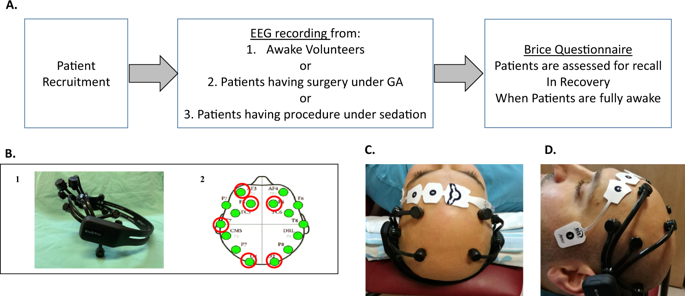Our official English website, www.x-mol.net, welcomes your
feedback! (Note: you will need to create a separate account there.)
A New Index of Coordinated Posterior and Anterior Evoked EEG to Detect Recall Under Sedation - A Pilot Study.
Scientific Reports ( IF 3.8 ) Pub Date : 2019-11-28 , DOI: 10.1038/s41598-019-54270-3 Dana Baron Shahaf 1, 2 , Gregory M T Hare 2, 3, 4, 5 , Andrew J Baker 2, 3, 4 , Violina Chenosia 1 , Leonid Priven 1 , Nikhil Mistry 2 , Goded Shahaf 6
Scientific Reports ( IF 3.8 ) Pub Date : 2019-11-28 , DOI: 10.1038/s41598-019-54270-3 Dana Baron Shahaf 1, 2 , Gregory M T Hare 2, 3, 4, 5 , Andrew J Baker 2, 3, 4 , Violina Chenosia 1 , Leonid Priven 1 , Nikhil Mistry 2 , Goded Shahaf 6
Affiliation

|
EEG-based technologies may be limited in identifying recall under sedation (RUS). We developed a novel index, posteriorization/anteriorization (P/A) index, based on auditory evoked EEG signal and assessed whether it could differentiate between patients with or without RUS. Methods: EEG and BIS were sampled from 3 groups: 1. Patients undergoing sedation (n = 26); 2. Awake volunteers (n = 13, positive control for recall) 3. Patients undergoing general anesthesia (GA, n = 12, negative control for recall). In recovery, recall was assessed using the BRICE questionnaire. Of the 26 sedated patients, 12 experienced recall. Both The P/A index and BIS differentiated between patients with recall and no recall. However, BIS differentiation may have been sensitive to the main drug used for sedation (midazolam vs. propofol) and the P/A index did not show similar drug-based sensitivity. Furthermore, only BIS results were correlated with EMG. Conclusion: This pilot study provided support for the association between P/A index and recall after sedation. Further research is needed in integrating the index into clinical use: (1) it should be derived by an easy-to-use EEG system with a better signal-to-noise ratio; (2) its applicability to other drugs must be shown.
中文翻译:

后和前诱发脑电图的新指标,以检测镇静情况下的召回率-一项先导研究。
基于EEG的技术在识别镇静下的回忆(RUS)时可能会受到限制。我们基于听觉诱发的EEG信号,开发了一种新的指数,后验/前验(P / A)指数,并评估了它是否可以区分伴或不伴RUS的患者。方法:从3组中抽取脑电图和BIS:1.进行镇静的患者(n = 26);2.清醒的志愿者(n = 13,召回阴性对照)3.接受全身麻醉的患者(GA,n = 12,召回阴性对照)。恢复后,使用BRICE问卷评估了召回率。在26例镇静患者中,有12例经历了回忆。P / A指数和BIS区分有回忆和无回忆的患者。但是,BIS分化可能对用于镇静的主要药物敏感(咪达唑仑vs. 丙泊酚)和P / A指数未显示相似的基于药物的敏感性。此外,只有BIS结果与EMG相关。结论:这项初步研究为镇静后P / A指数与召回之间的关联提供了支持。将指数整合到临床中还需要进一步的研究:(1)应该通过易于使用的脑电图系统来推导该指数,该系统应具有更好的信噪比;(2)必须证明其对其他药物的适用性。
更新日期:2019-11-29
中文翻译:

后和前诱发脑电图的新指标,以检测镇静情况下的召回率-一项先导研究。
基于EEG的技术在识别镇静下的回忆(RUS)时可能会受到限制。我们基于听觉诱发的EEG信号,开发了一种新的指数,后验/前验(P / A)指数,并评估了它是否可以区分伴或不伴RUS的患者。方法:从3组中抽取脑电图和BIS:1.进行镇静的患者(n = 26);2.清醒的志愿者(n = 13,召回阴性对照)3.接受全身麻醉的患者(GA,n = 12,召回阴性对照)。恢复后,使用BRICE问卷评估了召回率。在26例镇静患者中,有12例经历了回忆。P / A指数和BIS区分有回忆和无回忆的患者。但是,BIS分化可能对用于镇静的主要药物敏感(咪达唑仑vs. 丙泊酚)和P / A指数未显示相似的基于药物的敏感性。此外,只有BIS结果与EMG相关。结论:这项初步研究为镇静后P / A指数与召回之间的关联提供了支持。将指数整合到临床中还需要进一步的研究:(1)应该通过易于使用的脑电图系统来推导该指数,该系统应具有更好的信噪比;(2)必须证明其对其他药物的适用性。


















































 京公网安备 11010802027423号
京公网安备 11010802027423号